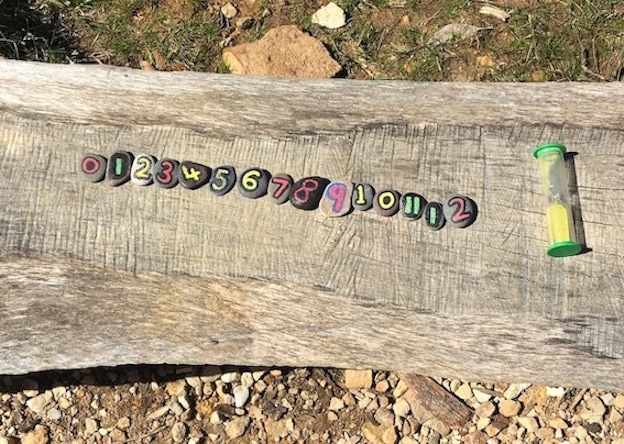

Messy Maths

Get Real. Get Messy. Get Maths. Get Outdoors.
There are many reasons why maths is a core part of the curriculum worldwide. It provides us with skills and knowledge that can be used in our daily lives. From the moment we wake up, we are constantly estimating, problem-solving and making quick judgements about quantities and amounts. For example, you may need to check you have the exact change for a bus or wonder if you can still fit into your trousers after several days of a festive celebration.
To help you think and plan maths experiences outdoors here are some practical suggestions:
Getting ready to go outside provides many mathematical moments:
- Time the class to get ready. This can be using a non-standard unit of measurement, such as a song for little children. With older children, this will be using a stopwatch or other timer.
- Use lining up to reinforce key data handling skills. For example, request children make two lines, e.g. those who are wearing green, those who are not wearing green. This creates a human line graph and can be used for counting and discussing differences between the length of each line. Change the attributes each time you go out. Your children will have plenty of suggestions here.
- Problem-solve with your class about ways of getting ready quickly and without fuss. Link these to the strategies used to solve problems, so children can see how a skill learned has real life applications.
Maths on the move. Make the most of the distance between your class and your outdoor space:
- Estimate the number of steps it takes to get outside. Discuss afterwards why everyone has a different answer. Is it possible to standardise this distance and how would we do this?
- Count aloud and chant in multiples, e.g. multiples of three on each step: 3, 6, 9, etc.
- What happens to your counting when you take five steps forward and one step back? Consider how to create links between numbers and the pattern of walking forwards and backwards.

Creating a gathering circle in mathematical ways
Explore the size of the circle made when children hold hands, stretch out and touch each other’s fingertips or huddle together shoulder-to-shoulder. Discuss and explore how the size could be measured. This may include:
- Pacing around the outside of the circle as a non-standard approach.
- Using a trundle wheel for noting metres or yards.
- Using a long piece or rope or string. If you put a mark at every metre or yard on the rope then it becomes a giant measuring tape.
Estimating everything
Children need lots of practice at estimating so they are able to make reasonable guesses based upon experience and knowledge. It is a basic strategy for problem solving and enquiry work as well as a useful life skill. Being outside provides a real context for estimating. It is hard to tell the number of birds in a flock, bricks in a wall or exactly how long it will take to walk to the shops. There is a constant need for everyone to be making estimates of amounts and activities based upon our experiences. Teachers can encourage the children estimate and then to check:
- Number: having a guess before counting the flock of birds flying overhead – we count ten birds and then use this to count the rest in chunks of ten.
- Money: evaluating whether we have enough money to buy something we need.
- Distance: estimating how far away the end of
the playing field is. - Volume: thinking about the volume of water in one bucket or watering can compared to another.
- Weight and mass: wondering how much food the birds will eat at a bird table.
- Time: considering how long it will take to complete a task.
It can help to make group estimates where there is a consensus. With older children, the skill of rounding up or down is a natural progression within estimation.

Playing maths games
All around the world there are strategy games, which were developed using locally found materials on a board that can be drawn onto an outdoor surface. Games involve looking for patterns and knowing the cause and effect of moves undertaken in particular sequences. This usually involves playing the game lots of times and experimenting with different moves. Some basic points include:
- Children need time to learn each game by just enjoying the experience of playing it. Older children can assist younger ones. Hold a games session so that parents and carers can learn different games too.
- If a game isn’t going well, ask the children for their ideas about making it better. What rules could be adapted or changed? How can they make the game more exciting?
- Games can be adapted to help the children acquire specific skills in many areas of maths. When you do this, it can be helpful to seek the children’s thoughts and suggestions. This gives them ownership of their learning and facilitates a personal interest.
- Children enjoy inventing their own games. Whether you have a pile of stones or a few leaves lying under a tree, challenge them to create a game to help them learn a specific maths concept or skill.
By Juliet Robertson, fo under of Creative STAR Learning, UK
under of Creative STAR Learning, UK
Many of these ideas are expanded upon in her book: Messy Maths: An Outdoor and Playful Approach for Early Years. There are also more than 750 outdoor ideas and suggestions on her blog, I’m a Teacher Get Me OUTSIDE Here! www.creativestarlearning.co.uk/blog
If you would like to participate in Outdoor Classroom Day, register your class or whole school, and share your day’s activities on social media using the #OutdoorClassroomDay hashtag.
Share
Find this article interesting? Share on social media to get friends and colleagues involved!











